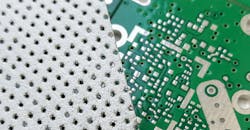All electrical devices emit magnetic or electrical energy due to radiation or conduction. Sometimes, electromagnetic interference (EMI) adversely affects the performance of a machine or the reliability of a transmission channel. Thus, it's often necessary to mitigate the problem by using EMI shielding materials.
The most common source of electromagnetic interference is radio frequencies between 1 kHz and 10 GHz. Other causes include arc welders and electrical noise.
EMI shielding involves either protecting a sensitive device or signal from electromagnetic interference or making it so that whatever emits the interference does not affect other equipment in the area. Here are nine of the most widely used options for EMI shielding.
1. Beryllium copper — This option has electrical properties that provide EMI shielding over a broad frequency range. Plus, beryllium copper's mechanical properties, including high tensile strength, offer a high deflection range and long lifespan. Moreover, beryllium copper is a corrosion-resistant material that can also tolerate ultraviolet rays and moisture.
If a person wishes to use a gasket for EMI shielding purposes, this material has mechanical spring properties that make it work well for high-motion applications. For example, if the goal is to shield an automatic door that opens and shuts for several combined hours per day, beryllium copper may be the right choice.
2. Stainless steel — Stainless steel is a less expensive option than beryllium copper. It's a suitable solution when situations do not require high attenuation — or the reduction of a signal's amplitude. Stainless steel is a stiffer choice than beryllium copper. Although stainless steel does not provide as much electrical conductivity as beryllium copper, the 301 series alloys give excellent corrosion-resistance and heat-tolerance.
3. Aluminum — Aluminum is another widely used choice. This non-ferrous material is generally cost-effective and it provides high conductivity. If durability is an issue in a build, aluminum offers a high strength-to-weight ratio. Since aluminum is easy to form, it offers the flexibility required to mold it into the necessary shapes for the best results.
People can buy it in several formats for EMI shielding purposes, with mesh being one of the most widely used and purchased options. Adhesive tape with aluminum on one side is also available.
4. Mesh composites — When builders or designers determine that a single material is not the best choice for their builds, composite materials may meet the EMI shielding requirements. A 2019 research paper tested the effectiveness of weaving wire-mesh composites into carbon fiber-reinforced plastics. The team working on the project determined that the combination of nickel and copper showed the best shielding performance.
5. Pre-tinplated steel — This option works well for shielding frequencies in the kHz to the lower GHz range. It's a modestly priced choice, and tinplating gives this material excellent corrosion resistance. Additionally, pre-tinplated steel's surface makes it possible to attach the shield to a board via soldering.
6. Copper alloy/alloy 770 — Copper alloy, more popularly known as alloy 770, is frequently chosen when developers prioritize corrosion-resistance in their builds. Copper effectively attenuates or absorbs electromagnetic radiation, and alloy 770 consists of copper, metal and zinc.
7. Silicone — Silicone for EMI shielding is readily available as gaskets. The common practice is to fill the silicon with a material such as carbon for conductivity. However, Dow Chemical recently introduced another way to use silicone for shielding, with a silicone adhesive. This option gives at least 150% elongation at joints, and it offers excellent flexibility while still adhering firmly to an assortment of substrates.
8. Conductive foams — When developers or engineers choose conductive foams for EMI shielding purposes, the foam material typically features a conductive covering. For example, one option available on the market is open-cell polyurethane foam with fabric made from nickel over copper-plated fabric on each side. Conductive foams usually have woven fabric on the mounting side, then non-woven, compliant fabric on the contact side.
9. Nickel — Nickel is a frequently used shielding material, either when as a plating on materials (such as plastics) or when added to silicone in particle form to increase conductivity.
While writing a 2016 research paper, a team used a computer-aided design (CAD) model of a circuit breaker coil to determine which materials had the best electromagnetic shielding properties. They cautioned that the overall effectiveness of shielding depends on factors including the shape and size of the shield, plus its distance from the shielded object. However, their results indicated that nickel and nickel-based materials gave the best performance for low-frequency applications.
No "best" choice for every application — This list provides a brief overview of some of the most common materials chosen for EMI shielding. When electromagnetic interference is a concern during a project, those involved must commit to selecting the material that matches their needs the best. Designers, engineers, and technicians should test their electronic systems regularly to make sure they are working properly. Frequencies, intended uses for the finished product, and cost are all things that can and should influence a decision to pick what to use for each electronic component.
Megan Nichols is a STEM writer and blogger who writes on a wide range of scientific topics at schooledbyscience.com. Here recent works has included Save Money by Fixing and Preventing Compressor Leaks and A Quick Guide to Building a Successful Metal Fabricating Business. Follow Megan on Twitter @nicholsrmegan.
About the Author
Megan R. Nichols
STEM writer and blogger
Megan Nichols is a STEM writer and blogger covering a wide range of scientific topics at schooledbyscience.com
